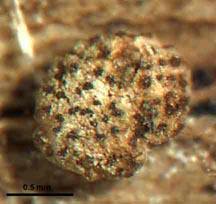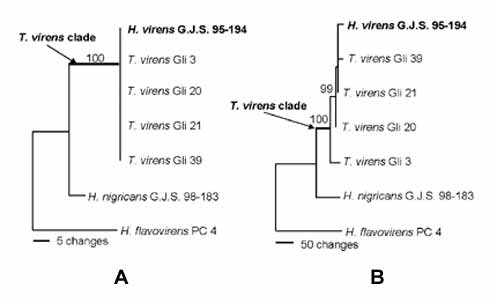|
Chaverri, P., Samuels, G.J., and Stewart, E.L. 2001. Mycologia 93:1113-1124
| Abstract: The new species Hypocrea virens, has been found to be the teleomorph of Trichoderma virens, a species commonly used in biological control applications. This conclusion is based on the comparison of morphological and molecular data from four isolates of T. virens and a single collection and isolate of H. virens. Data for several morphological characters, including colony and growth characteristics, were collected. In addition, sequence data from ITS1, 5.8S, ITS2 rDNA and translation elongation factor (TEF) were analyzed for the five isolates. Analysis of phenotypic characters show that cultures and microscopic characters of the anamorph of H. virens are indistinguishable from those of T. virens. This is consistent with sequence data from ITS1, 5.8S, ITS2 rDNA which show that the sequence of H. virens is identical to that of the ex-type isolate of T. virens. Despite minor variation in TEF sequences, T. virens isolates and H. virens form a monophyletic group that is different from other examined species of Hypocrea; this clade is supported by a 100% bootstrap value. Molecular and morphological data confirm the connection between H. virens and T. virens. |
Visit the Trichoderma Identification Aid for an interactive key, images, descriptions, distributions, literature and nomenclature for the genus Trichoderma
 |
Description of Hypocrea virens
Hypocrea virens Chaverri, Samuels & E.L. Stewart, Mycologia 93 (6): in press. 2001.
Stromata solitaria, albolutea, (0.7--)0.8--1.0(--1.4) mm. Asci cylindrici, (85--)95--103(--114) x (5.0--)5.5--6.0(--6.5) µm, apice incrassato praediti. Ascosporae bicellulares, ad septum disarticulatae; globosae ad subglobosae, parte distali (4.0--)5.0--5.5(--6.5) x (4.0--)5.0--5.5(--6.5) µm, parte proximali (4.0--)5.0--5.5(--6.5) x (4.5--)5.0--5.5 µm, atrovirentes, verrucosae. HOLOTYPUS: Herb BPI 737768.
Teleomorph: Stromata solitary and scattered, pulvinate, light yellow, KOH+, nearly circular in outline, (0.7--)0.8--1.0(--1.4) mm diam (n=14), (0.7--)0.8 mm (n=10) high, with a wide base, surface smooth with slight perithecial protuberations, (13--)25--50(--80) perithecia per stroma (n=12), ostiolar openings narrow, visible due to green contents of centrum. Stroma surface (25--)26--33 µm thick (n=10), formed of angular cells, slightly pigmented almost hyaline, KOH+, (7.0--)10.0--11.5(--14.0) µm diam, densely compacted with walls 0.5--1.0 µm thick. Tissue immediately below the stromatal surface of compact to loose, pseudoparenchymatous cells, textura angularis to t. epidermoidea, colorless, KOH-, (4.5--)8.5--10.0(--14.5) µm diam, walls 0.5--1.0 µm thick. Internal tissue below perithecia formed of angular cells, colorless, KOH-, (7.0--)11.0--13.0(--17.5) µm diam, walls (0.2--)0.5--0.7(--1.0) µm thick. Perithecia generally widely spaced, subglobose, (175--)180--218(--241) µm high (n=8), (95--)127--174(--184) µm wide (n=8), ostiolar canal (49--)56--80 µm long (n=8), wall KOH+. Asci cylindrical, (85--)95--103(--114) x (5.0--)5.5--6.0(--6.5) µm (n=20), with a slightly thickened tip; part-ascospores uniseriate. Part-ascospores slightly dimorphic, globose to subglobose, distal part globose to subglobose (4.0--)5.0--5.5(--6.5) x (4.0--)5.0--5.5(--6.5) µm, proximal part globose to subglobose sometimes slightly tapered (4.0--)5.0--5.5(--6.5) x (4.5--)5.0--5.5 µm, dark green, warted.
Anamorph:
Trichoderma virens (Miller, Giddens & Foster) Arx, Nova Hedwigia Beih. 87: 288. 1987.
= Gliocladium virens Miller, Giddens & Foster, Mycologia 49:792. 1957.
Colonies on CMD growing rapidly, approximately 5.0-6.0 cm; on PDA 4.5--7.0 cm, after 4 days at 25 C. The optimum temperature for growth is 25--30 C, both on CMD and PDA. Colonies on CMD, flat with some aerial mycelium. Conidia are produced concentrically or near the margin of the plate. Colonies on PDA, floccose with effuse conidiation typically covering the entire surface of the plate. A yellow pigmentation of the agar is sometimes present on both CMD and PDA. Conidiophores hyaline, smooth-walled 12.4--133.0 x 4.2--6 µm. Phialides lageniform to ampulliform, length 8.6--9.9 µm, base 2.1--2.7 µm wide, width at the widest 3.4--4.5 µm. Metulae (subtending hyphae) cylindrical, 8.5--13.8 x 2.7--4.8 µm. Conidia green, smooth, broadly ellipsoidal to obovoid, 4.2--4.9 x 3.6--4.2 µm. Chlamydospores abundant, terminal or intercalary, subglobose, 6.3--12.4 x 6.1--10.1 µm. For a more detailed description, refer to Miller et al (1957) and Bissett (1991).
Habitat: The teleomorph was found on decorticated wood, probably growing on black mycelium of another fungus. Trichoderma virens has been isolated from soil, other fungi, and decaying woody substrata.
Known distribution: The teleomorph is known only from the type locality in Indiana, USA. The anamorph is cosmopolitan.
Holotype: UNITED STATES. INDIANA: Brown County, vic. Pike's Peak, Happy Hollow Camp, 39°09'N, 86°06'W, elev. 250 m, 29 Sep 1995, G.J. Samuels 95-194 (BPI 737768; CBS 109339; ATCC MYA-1298).
Other specimens examined: Trichoderma virens isolates: Gli 20 and Gli 21, laboratory isolates of unknown origin; UNITED STATES. OREGON: Rainier, isolated from roots of Pseudotsuga menziesii infected with Phellinus weirii, E. Nelson #27, isolate Gli 3. GEORGIA: Beckley County, Norfolk, Gli 39 (= ATCC 13213, CBS 249.59) from J.C. Giddens 167 (BPI, ex-type culture of Gliocladium virens).

A. Parsimony analysis of ITS1, 5.8S, ITS2 rDNA. One of two most parsimonious trees; 57 steps; consistency index: 1.0; retention index: 1.0; homoplasy index: 0.0; bootstrap values (500 repetitions) indicated above branches. Outgroup taxa: H. flavovirens and H. nigricans.
B. Parsimony analysis of TEF. One of five most parsimonious trees; 481 steps; consistency index: 0.97; retention index: 0.74; homoplasy index: 0.03.; bootstrap values (500 repetitions) indicated above branches. Outgroup taxa: H. flavovirens and H. nigricans.
*The teleomorph is in bold.
References:
Bissett J. 1991b. A revision of the genus Trichoderma. III. Section Pachybasium. Can J Bot 69:2373-2417.
Miller J.H., Giddens J.E., Foster A.A. 1957. A survey of the fungi of forest and cultivated soils of Georgia. Mycologia 49:779-808.
|